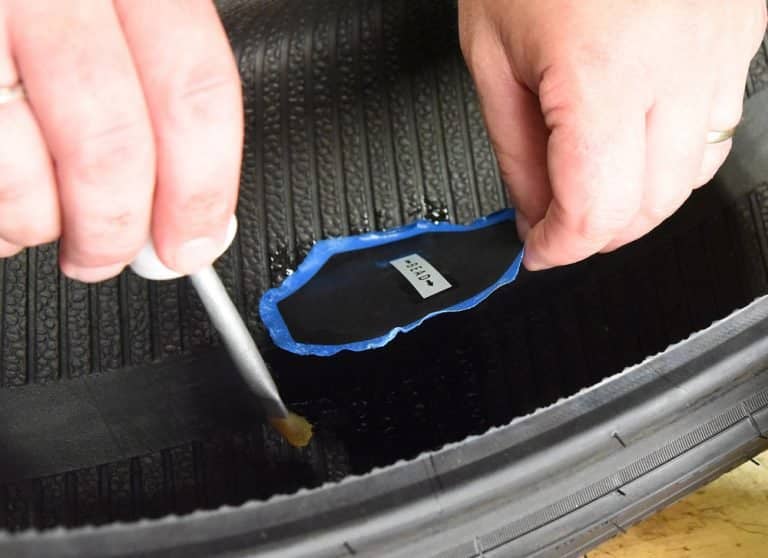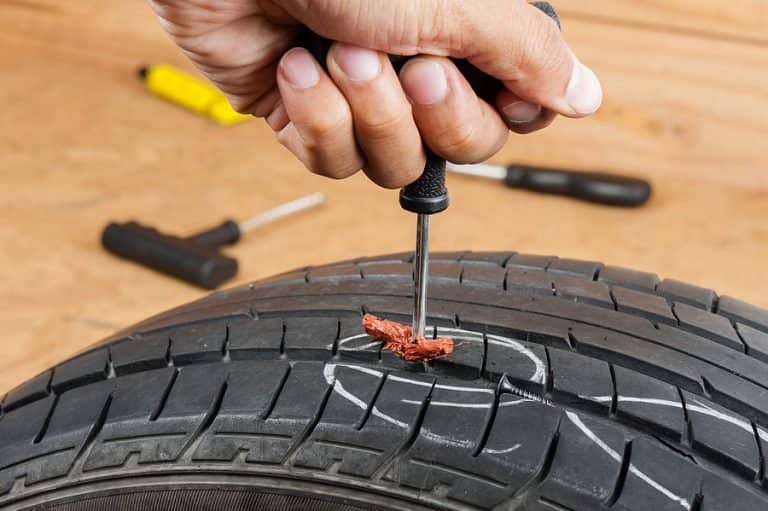When embarking on long journeys, tire damage can be a common concern, with tire punctures being one of the most frequent issues. However, patching tires can offer an effective solution that saves both time and money. In this article, we will delve deeper into the world of patched tires, exploring their lifespan, safety, different repair methods, and essential maintenance tips to ensure optimal longevity.

How Long Does a Patched Tire Last?
If a tire undergoes proper patching and repairs following standard procedures, it can last for an impressive 7-10 years. The lifespan may vary slightly based on the specific patching method used, but the difference is generally negligible when considering the overall distance covered.
To maximize the life of a patched tire, certain rules should be strictly adhered to, such as avoiding collisions in hazardous areas, refraining from excessive speeding, and limiting the number of times a tire is patched. Multiple patches can lead to severe speed issues and pose a risk of sudden blowouts while driving, especially during prolonged use.
It is highly recommended to visit a reputable maintenance center where experienced professionals can assess the most suitable repair plan for your vehicle.
Types of Repairs and Their Durability:

- Plug Repair: The plug repair method involves using adhesive to seal the hole and prevent gas leakage. However, car tire companies do not endorse this method due to potential long-term issues. Over time, environmental factors, such as exposure to air, can cause the plug and tire to deteriorate, leading to loss of the protective shield, structural damage, and potential separation, which is hazardous for the driver.
- Patch Repair: To increase the success rate of patching a tire, it is crucial to closely observe and accurately identify the position of the puncture. Removing the tire from the rim facilitates easy inspection. Once the puncture is localized, specialized tools should be employed for the patching operation.
The puncture site requires meticulous polishing, and the process of applying cementation to the patch and inner lining of the tire ensures a secure bond between the two. Additional reinforcement can be achieved through stitching, overcoating with gray matter, or using heat to effectively repair the damaged rubber. This thorough process typically takes around 20-30 minutes, but the patched tire can last up to 7-10 years, as recommended by the manufacturer. - Repair Patch-Plug: Combining both patching and plugging methods can increase the success rate of tire repairs. This involves locating a clean surface around the hole for proper repair, applying cementitious adhesive evenly, and fitting a rubber pad to both prevent air leakage and cushion the wheel. Experts recommend this as a robust reinforcement method to ensure airtightness and extend the tire’s lifespan.
Is It Safe to Drive with a Patched Tire?
Driving with a patched tire is generally safe, and it is a better option compared to driving on a spare or flat tire. A properly patched tire can function just like a regular one, even on rough roads. However, for longer and safer use, it is advisable to limit high-speed driving. If you frequently drive at high speeds, it is best to replace the tire with a new one to ensure optimal safety.
Frequently Asked Questions (FAQ) – Patched Tires
- How long does a patched tire last?
Patched tires can last for an average of 7-10 years or more, provided they are repaired correctly and follow standard procedures. - How long can I drive on a patched tire?
You can drive on a properly patched tire for its entire lifespan of 7-10 years, as long as it remains in good condition and follows safety guidelines. - Is it safe to drive with a patched tire?
Yes, driving with a properly patched tire is safe. A well-repaired tire functions like a regular one and is secure for everyday driving. - Does patching a tire fix it permanently?
Patching a tire can provide a permanent solution if done correctly. Properly patched tires can last for many years. - Is patching a tire good enough?
Yes, patching a tire is a reliable method to fix punctures, and it can extend the tire’s life for a considerable duration. - Are patched tires safe at high speeds?
Patched tires are generally safe at high speeds, but for optimum safety, it’s advisable to limit high-speed driving. Consider replacing the tire if you frequently drive at high speeds. - When should I replace my patched tire?
You should consider replacing a patched tire if it has exceeded its recommended lifespan or if it shows signs of severe wear or damage. - Do tire patches fail?
Properly done tire patches rarely fail. However, if a patch is not done correctly or the tire sustains additional damage, the patch may not hold up. - Is it better to patch or replace a tire?
If the tire is repairable and not too worn, patching is a cost-effective and safe option. However, if the tire is severely damaged or has exceeded its lifespan, it’s better to replace it. - Is it better to plug or patch a tire?
Patching is generally considered more reliable and safer than plugging. Plugging is often a temporary fix and may not hold up over time. - Can a tire be patched instead of replaced?
Yes, if the tire has a repairable puncture and is in good overall condition, it can be safely patched instead of replaced. - Can I drive long distances with a plugged tire?
It’s not advisable to drive long distances with a plugged tire. Plugging is typically considered a temporary solution, and extended driving may compromise safety. - Do tires last longer if you drive slower?
Driving slower can help reduce tire wear and extend their lifespan. Gentle driving habits and proper maintenance contribute to longer-lasting tires. - Which tire wears out fastest?
The front tires tend to wear out faster than the rear ones, especially on front-wheel-drive vehicles. - Is it OK to patch a tire twice?
While patching a tire twice may be possible if the holes are not too close together, it is generally not recommended. Multiple patches can compromise the tire’s structural integrity and safety. - Does a tire patch last longer than a plug?
Yes, a tire patch typically lasts longer than a plug. Patching involves a more thorough repair process, ensuring a more reliable and durable fix. - Can I leave a screw in my tire?
Leaving a screw in your tire is not safe. It can cause further damage and lead to air leakage, increasing the risk of a flat tire or blowout. - How long do tires last?
The lifespan of tires varies depending on factors like usage, road conditions, and maintenance. On average, tires can last anywhere from 5 to 10 years. - How do tire shops fix nail holes?
Tire shops usually repair nail holes by patching the tire. They remove the nail, inspect the puncture, and apply a patch from the inside to seal the hole. - Can you trust a tire plug?
Tire plugs can be effective temporary solutions for minor punctures, but they are not as reliable as proper patches for long-term use. - What tires cannot be patched?
Tires with extensive damage, sidewall punctures, or those that have exceeded their recommended lifespan cannot be patched and should be replaced. - Do tires wear faster if you drive faster?
Yes, driving at higher speeds can increase tire wear and decrease their lifespan due to increased friction and heat buildup. - Do cheap tires wear faster?
In general, cheaper tires may wear out faster than higher-quality tires due to differences in construction and materials. - Do tires wear faster as they age?
Yes, tires can wear out faster as they age, even if they have not been driven much. The rubber can deteriorate over time, affecting tire performance. - Can I put 2 new tires on the front?
It is recommended to replace all four tires at once for optimal safety and performance. However, if replacing only two, they should go on the rear to maintain stability during wet conditions. - Do tires wear faster front or rear?
Front tires tend to wear out faster than rear tires, especially on front-wheel-drive vehicles, due to the additional weight and steering forces. - Is it OK to change the front tires only?
While changing only the front tires is possible, it is best to replace all four tires at the same time to maintain balanced handling and safety. - Do I need a new tire if I have a nail in it?
If the nail puncture is small and in a repairable area, a proper patch can fix it. However, if the damage is extensive or in an unsafe location, the tire may need replacement. - How strong is a patched tire?
A properly patched tire is structurally sound and can maintain its strength and integrity as long as it is repaired following recommended guidelines. - How long does a tire patch take to dry?
Tire patches typically dry within 30 minutes. If the patch does not dry within this timeframe, it may indicate an issue with the adhesive or the repair process. - Will tire sealant fix a slow leak?
Tire sealant can temporarily fix a slow leak in some cases, but it is not a permanent solution. It is best to have the tire inspected and repaired by a professional.
Conclusion:
When dealing with a punctured tire, there are several options, including replacing it with a new one or opting for patching. While changing tires is the ideal choice for ensuring safe driving, patching can be a time-saving and effective alternative when performed correctly.
In this article, we have provided essential information regarding patched tires, including their lifespan, safety, repair methods, and maintenance tips. By following these guidelines, you can extend the life of your patched tire and enjoy worry-free driving. Remember, safety should always be the top priority, so seek professional support and adhere to recommended guidelines for the best results.
Thank you for reading!